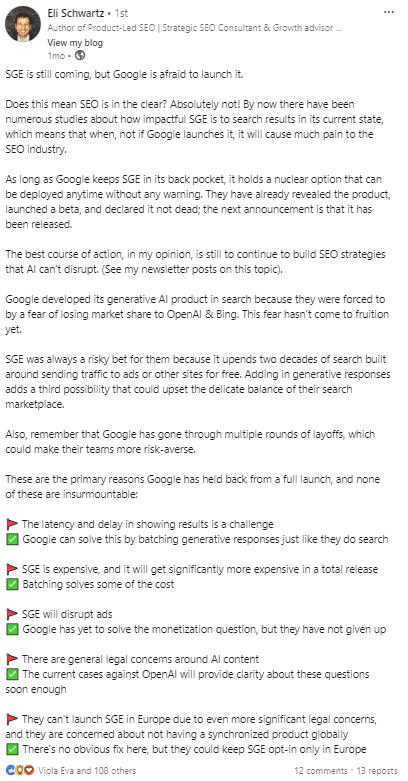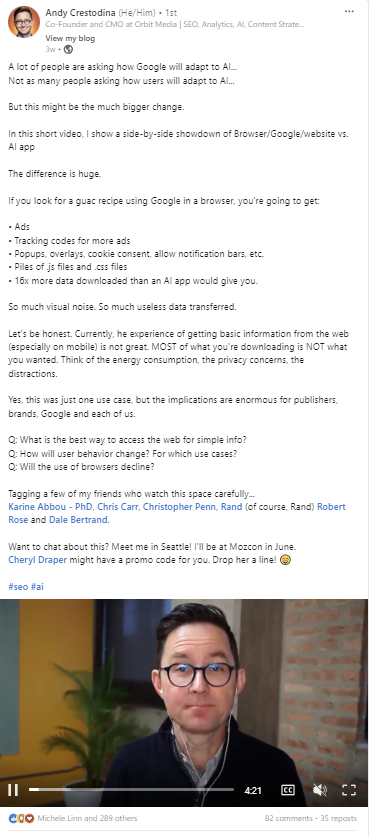Google Search Generative Experience (SGE) has caused anxiety amongst the SEO world, but it’s not time to run for the hills yet.
Before you claim that “SGE has killed SEO,” remember that it’s still very much a work in progress, and we don’t know what impact it will have or how its functionality will change.
If organic traffic decreases as a consequence of SGE, that doesn’t necessarily mean SEO has become a less viable channel – because all marketing channels have become more expensive and less impactful over time as they become more saturated.
So, what should you change now that SGE is here?
Well, just like withstanding any algorithm update, it’s important to continue focusing on core E-E-A-T and quality content factors, as that is the best way to withstand traffic losses.
As a marketer, this means you need to redefine how SEO performance is benchmarked so it’s not perceived as a disappointment. It’s time to throw out the technique of using SEO as a siloed channel and pave the way for multi-channel marketing, as it’s the way of the future.
To help maintain SEO’s overall performance amidst these changes, there are a few strategies you can adopt to prepare for Google SGE and create a successful multi-channel marketing strategy.
What Is Google SGE?
Google Search Generative Experience (SGE) is an AI-powered program that aims to create a more “natural” way to conduct research or dig deeper on a topic.
It provides in-depth overviews of topics directly in the SERPs, reducing the need to click through several different web pages to find an answer.
Unlike the Featured Snippets already in place on Google, SGE provides a wider range of information, including links, images, and intuitive ways to deepen user experience.
Essentially, it’s a “natural” way to simplify research and streamline Google searches.
For example, SGE allows you to ask follow-up questions right on the SERPs rather than starting a new query.
 Screenshot from search for [how to play with a golden retriever puppy], Google, February 2024
Screenshot from search for [how to play with a golden retriever puppy], Google, February 2024SGE is not technically a certified feature and is only offered through Google Labs. As of today, it’s available in the US and is functioning in 120 countries worldwide. It’s offered in five languages: English, Spanish, Portuguese, Korean, and Indonesian.
This currently excludes the EU due to strict data privacy laws, and it’s hard to say whether it’ll ever reach these markets because of this.
It’ll be interesting to see how things change over time, but we can only wait and see.
Google Hesitates To Do A Full Launch Due To A Lack Of Monetization
Although there are some innovative aspects to SGE in theory, it’s still considered more of a concept rather than a full-blown product launch. Google still hasn’t really figured out what to do with it, and the entire program remains under a lot of speculation.
Since its origination, SGE has been a bit of an experiment that keeps being extended. But this isn’t exactly new behavior for Google. In reality, it seems like we may have been introduced to SGE because Microsoft integrated ChatGPT into Bing.
Google likes keeping AI in the background, as it has been doing with its programming since RankBrain came out in 2015.
With SGE, AI becomes the forerunner of SERPs, which results in some new obstacles, as described by Eli Schwartz, Strategic SEO & Growth Advisor:
 Screenshot from LinkedIn, February 2024
Screenshot from LinkedIn, February 2024Despite all the “red flags,” that doesn’t mean SGE is going away. And, in the marketing world, the functionality fluctuations within SGE will continue to bring about changes for day-to-day SEO operations.
What Impact Is SGE Predicted To Have On SEO Performance?
Every marketer is wondering how SGE will affect SEO performance. Since it’s forecasted to push organic traffic down due to fewer links in the SERPs, what can we expect?
Well, let’s take a look at three studies:
The first study, conducted by the Wall Street Journal, found that the same media sites are estimated to lose 20-40% of SEO traffic from Google SGE.
A second study conducted by BrightEdge analyzed over 1 billion queries across 9 different industries. You can see the impact of SGE by industry in the chart below:
 Image from BrightEdge, February 2024
Image from BrightEdge, February 2024What does this mean, exactly? As with many things in SEO, “it depends,” but largely because of the differences in industry impact.
Although SGE is bound to change things, is it possible to forecast how much traffic you’d lose? And if you know what to expect, could you adapt your strategy to benefit from Google SGE rather than focus on a loss?
The key is trying to estimate how much your traffic will be affected by Google SGE and then taking a proactive approach to amending your content.
Once you do this, it is possible to optimize pages so that you have the chance to appear in SGE snapshot carousels.
5 Tips For Optimizing SEO Strategies For Organic Traffic Changes Related To SGE
Even though it’s hard to say today how SGE will impact SEO, it’s important to focus less on the doom of traffic loss and look toward the opportunity to appear in SGE snapshots.
Here are a few strategies you can use to do precisely that.
1) Assess The Current Risk Of SGE On Organic Traffic
The first thing you’ll need to do is see how SGE could impact your current traffic.
Aleyda Solís, International SEO Consultant & Founder at Orainti, put together a helpful risk assessment sheet that makes it easy to identify potential risks for various queries.
It takes into account three different types of SGE snapshots: duplicative, summarizing or complementary, and accelerator, in addition to the level of user satisfaction and fulfillment in their journey.
 Screenshot from LinkedIn, February 2024
Screenshot from LinkedIn, February 2024After assessing the risk of SGE on your organic traffic, you’ll get a better idea of where to focus your SEO efforts.
Additionally, marketers will need to redefine how SEO performance is benchmarked so it’s not perceived as a disappointment. Then, you can calculate organic traffic losses and update KPIs to reflect this.
2) Transition SEO Focus From #1 Keyword Rankings To Holistic Organic SERP Visibility
Another way to adapt and overcome is to stop focusing on #1 keyword rankings as the benchmark of successful SEO efforts. Holistic, organic SERP visibility is far more beneficial and will help you succeed in conjunction with Google SGE.
Even if you’re ranking as one of the top results for specific keywords now, a study on SGE from Authoritas found that nearly 94% of the links in Google SGE don’t match the top 10 organic search results.
This is great news if you’re struggling to rank for a certain keyword, but can still manage to appear in SGE snapshots.
Overall, try to focus less on the link positioning and more on overall brand appearance and content. Google SGE has incorporated some links to make it easier for users to visit pages that are backing up what’s being presented in the summary.
Google mentions how this reduces the issues of potential misinformation while adding a complementary feature to traditional search rather than a replacement (and here of course is where all SEO pros breathe a sigh of relief).
3) Hone In On E-E-A-T
More than anything, it’s necessary to use your Experience, Expertise, Authoritativeness, and Trustworthiness (E-E-A-T) to showcase your content.
This allows you to adapt to AI rather than waiting for Google to adapt to it and then adjusting accordingly. As Andy Crestodina, Co-Founder and CMO at Orbit Media, says in his video, “It’s time to focus more on the user and less on Google.”
 Screenshot from LinkedIn, February 2024
Screenshot from LinkedIn, February 2024Google’s SERPs are being skewed by SGE, AI updates, and even things as simple as affiliate marketing.
In a recent study that looked at 7,392 product-review search terms across Google, Bing, and DuckDuckGo, the highest-ranked pages were more optimized and had more affiliate links, but their text and quality were lower.
This could be one of the reasons the links in Google SGE don’t match the top 10 SERP results, and focusing on quality content can help keep you relevant despite ongoing changes.
With the quality of Google search results on the decline and AI content prosecution fully in play, the best way marketers can react is to include as much brand-specific and SME content as possible to meet E-E-A-T criteria.
4) Keep Note Of Algorithmic Changes In Market-specific SGE Features
As SGE continues to roll out, it’s important to keep an eye on how things are changing. It seems like the features are extremely dynamic, with major differences in identical search queries from one user to another.
A recent example test from Aleyda Solis shows how Google SGE features are, in a way, mimicking big retailers, but it’s not necessarily what we should expect.
In reality, there are tons of changes happening all the time, so it’s imperative that you track changes related to your industry.
And get used to change – it seems like SERP volatility is the new way of SEO life.
5) Don’t Silo SEO And Shift Focus To Multi-channel Marketing
In the dynamic landscape of Google SGE development and AI-powered advancements, thriving in the SERPs requires a strategic shift from relying on SEO as a solo channel to drive business growth.
Embracing multi-channel marketing is the best way to ensure your strategy aligns with the evolving demands of the industry – it’s the way of the future.
To achieve this, there are three important things you need to do:
- Assess the customer journey holistically: This means considering the entire customer journey and its multiple touchpoints. Keep in mind that customer interactions occur across different platforms and channels, and they all need to be considered.
- Deploy synergistic collaboration across different channels: In marketing, each channel plays a part in driving conversions, and they’re all interconnected. You can utilize GA4 conversion tracking for a deeper understanding of your customer touchpoints.
- Diversify your strategy to help mitigate risks: When you rely solely on SEO or any single marketing channel, you’re setting yourself up for failure. Exclusively relying on one channel is not going to meet the diverse needs of today’s customers – it’s far too limited.
Navigating The Future Of SEO Amongst The Uncertainty Of Google SGE
As uncertainty about SGE looms, it’s crucial for marketers to stay calm and use the tools they have to strategically adapt.
Although SGE poses some potential challenges, especially regarding organic traffic, the program is still in the experimental phases, and its full impact remains uncertain.
While Google SGE may introduce a new dimension to how people make search queries online, it also presents an opportunity.
Now, marketers have the chance to redefine their strategies and embrace the future of multi-channel marketing before being buried by organic traffic losses and AI-powered replacements.
More resources:
Featured Image: /Shutterstock

